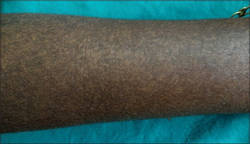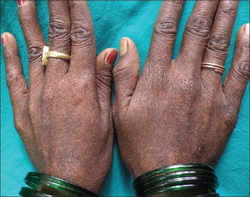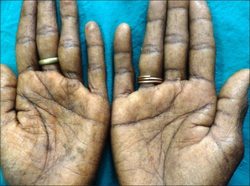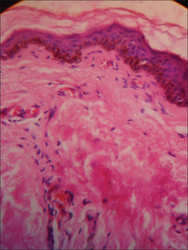Reticulate acropigmentation of Kitamura
| Reticulate acropigmentation of Kitamura | |
|---|---|
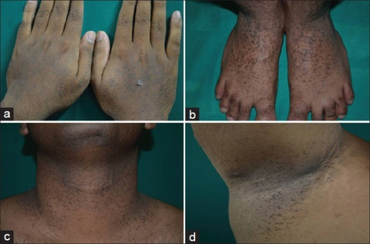 | |
| Reticulate hyperpigmentation on: a) Dorsa of both hands b) Dorsa of both feet c) Neck d) Axilla | |
| Specialty | Dermatology |
| Symptoms | Colored freckle-like and slightly depressed spots arranged in a lace-like pattern on the backs of hands and feet[1] |
| Usual onset | Adolescence and young adults[1] |
| Causes | Autosomal-dominant[1] |
| Differential diagnosis | Dowling–Degos disease[1] |
| Frequency | Rare[1] |
Reticulate acropigmentation of Kitamura (RAK), is a type of pigmentation disorder of the skin.[1] It presents with colored freckle-like and slightly depressed spots arranged in a lace-like pattern on the backs of hands and feet.[1] It tends to occur in skin folds of adolescents and early adulthood, and darkens over time.[1]
It is inherited in an autosomal-dominant fashion.[1]
The condition is rare.[2] It was first described in Japan, before recognising that is also occurs elsewhere.[1]
Signs and symptoms
-
Hyperpigmented macules of forearms
-
Freckle-like marks on back of hands
-
Fine pitting of the palms
Diagnosis
-
Increased melanization of the basal layer with slightly atrophic epidermis (H and E, ×40)
Genetics
This condition is associated with mutations in the a disintegrin and metalloproteinase domain-containing protein 10 (ADAM10) gene. This association was first shown in 2013.
See also
References
- ↑ 1.0 1.1 1.2 1.3 1.4 1.5 1.6 1.7 1.8 1.9 James, William D.; Elston, Dirk; Treat, James R.; Rosenbach, Misha A.; Neuhaus, Isaac (2020). "36. Disturbances of pigmentation". Andrews' Diseases of the Skin: Clinical Dermatology (13th ed.). Edinburgh: Elsevier. p. 867. ISBN 978-0-323-54753-6. Archived from the original on 2023-07-01. Retrieved 2023-05-04.
- ↑ "Orphanet: Reticulate acropigmentation of Kitamura". www.orpha.net. Archived from the original on 25 November 2020. Retrieved 23 April 2019.
External links
| Classification | |
|---|---|
| External resources |
